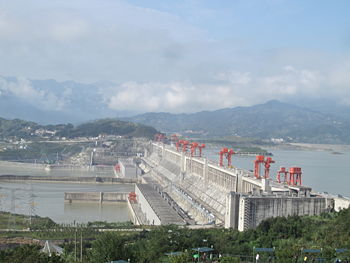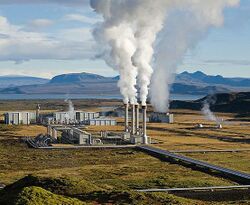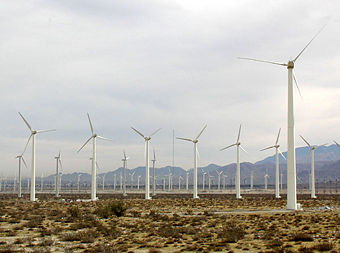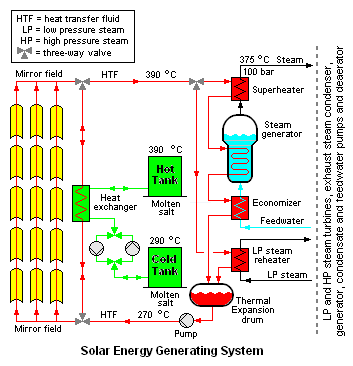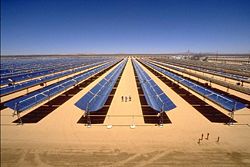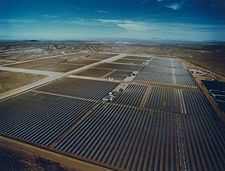Renewable energy
Renewable energy development involves three generations of renewable energy technologies dating back more than 100 years. First-generation technologies, which are already mature and economically competitive, include biomass power, hydroelectric power, and geothermal power and heat. Second-generation technologies are market-ready and are being deployed at the present time. They include solar power plants, photovoltaics, wind power plants, solar power plants, and modern forms of bioenergy. Third-generation technologies require continued research and development (R&D) efforts before they are market-ready and they include advanced biomass gasification, biorefining technologies, hot-dry-rock geothermal power, tidal power, and other forms of ocean energy.[1][2]
Renewable energy technologies are essential contributors to the energy supply portfolio, as they contribute to world energy security, reduce dependency on fossil fuels, and provide opportunities for reducing greenhouse gas emissions.[1]
Overview
The term renewable energy covers a number of sources and technologies at different stages of commercialization. The International Energy Agency (IEA) has defined three generations of renewable energy technologies, reaching back over 100 years:
- First-generation technologies emerged from the industrial revolution at the end of the 19th century and include hydropower, biomass power, and geothermal power and heat. These technologies are quite widely used.[1]
- Second-generation technologies include solar heating and cooling, wind power, modern forms of bioenergy, and solar photovoltaics. These are now entering markets as a result of research, development and demonstration (RD&D) investments since the 1980s. Initial investment was prompted by energy security concerns linked to the oil crises of the 1970s but the primary appeal of these technologies is due, at least in part, to environmental benefits. Many of the technologies reflect significant advancements in materials of construction.[1]
- Third-generation technologies are still under development and include advanced biomass gasification, biorefinery technologies, concentrating solar thermal power, hot dry rock (HDR) geothermal power, and ocean energy. Advances in nanotechnology may also play a major role.[1]
First-generation technologies are well established, second-generation technologies are emerging technologies, and third-generation technologies heavily depend on long-term R&D commitments, where the public sector has a role to play.[1]
First-generation technologies
First-generation technologies are widely used in locations with an abundance of the appropriate natural resources. Their future use depends on the exploration of the remaining resource potential, particularly in developing countries, and on overcoming challenges related to the environment and social acceptance.
Biomass
Biomass commonly refers to renewable organic materials such as wood, wood waste, straw, sugar cane, algae, and many other byproducts derived from a variety of agricultural and forestry production as well as other sources. Since biomass is derived from plants which were generated by utilizing solar energy in the photosynthesis process, it can also be defined as the organic material on Earth that has stored solar energy in the chemical bonds of the organic material.
The use of biomass for producing heat and electric power is a fully mature technology which offers a ready disposal mechanism for municipal, agricultural, and industrial organic wastes. However, the industry has remained relatively stagnant over the decade to 2007, even though demand for biomass (mostly wood) continues to grow in many developing countries. One of the problems of biomass is that material directly combusted in cook stoves produces pollutants, leading to health and environmental consequences, although improved cook stove programs are alleviating some of these effects. First-generation biomass technologies can be economically competitive, but may still require gaining public acceptance and overcoming small-scale issues.[1]
Hydroelectricity
Hydroelectric power plants have the advantage of being long-lived and many existing plants have operated for more than 100 years. Hydropower is also an extremely flexible technology from the perspective of power grid operation. Large hydropower provides one of the lowest cost options in today’s energy market, even compared to fossil fuels and there are no harmful emissions associated with plant operation.[1]
Hydroelectric power is currently the world’s largest installed renewable source of electricity, supplying about 17% of total electricity in 2005.[3] China is the world's largest producer of hydroelectric power in the world, followed by Canada.
However, there are several significant social and environmental disadvantages of large-scale hydroelectric power systems: dislocation of people living where the reservoirs are planned, release of significant amounts of carbon dioxide (CO2) during construction and flooding of the reservoir, and disruption of aquatic ecosystems and birdlife.[4] Hydroelectric power is now more difficult to site in developed nations because most major sites within these nations are either already being used or may be unavailable for environmental reasons. The areas of greatest hydroelectric growth are the growing economies of Asia. India and China are the development leaders; however, other Asian nations are also expanding hydropower.
There is a strong consensus now that countries should adopt an integrated approach towards managing water resources, which would involve planning hydropower development in co-operation with other water-using sectors.[1]
Geothermal power and heat
Geothermal power plants can operate 24 hours per day, providing baseload capacity. Estimates for the world potential capacity for geothermal power generation vary widely, ranging from 40 GW by 2020 to as much as 6,000 GW.[5][6]
Geothermal power capacity grew from around 1 GW in 1975 to almost 10 GW in 2008.[6] The United States is the world leader in terms of installed capacity, representing 3.1 GW. Other countries with significant installed capacity include the Philippines (1.9 GW), Indonesia (1.2 GW), Mexico (1.0 GW), Italy (0.8 GW), Iceland (0.6 GW), Japan (0.5 GW), and New Zealand (0.5 GW).[6][7] In some countries, geothermal power accounts for a significant share of the total electricity supply, such as in the Philippines, where geothermal represented 17 percent of the total power mix at the end of 2008.[8]
Geothermal ground source heat pumps represented an estimated 30 gigawatts-thermal (GWth) of installed capacity at the end of 2008, with other direct uses of geothermal heat (i.e., for space heating, agricultural drying and other uses) reaching an estimated 15 GWth. As of 2008, at least 76 countries use geothermal energy in some form.
Second-generation technologies
Markets for second-generation technologies have been strong and growing over the past decade, and these technologies have gone from being a passion for the dedicated few to a major economic sector in countries such as Germany, Spain, the United States, and Japan. Many large industrial companies and financial institutions are involved and the challenge is to broaden the market base for continued growth worldwide.[1]
Solar Heating
Solar heating systems are a well known second-generation technology and generally consist of solar thermal collectors, a fluid system to move the heat from the collector to its point of usage, and a reservoir or tank for heat storage. The systems may be used to heat domestic hot water, swimming pools, or homes and businesses. The heat can also be used for industrial process applications or as an energy input for other uses such as solar assisted air conditioning.[9]
In many warmer climates, a solar heating system can provide a very high percentage (50 to 75%) of domestic hot water energy. As of 2009, China has 27 million rooftop solar water heaters.[10]
Photovoltaics
Photovoltaic (PV) cells, also called solar cells, convert light into electricity. In the 1980s and early 1990s, most photovoltaic modules were used to provide small, stand-alone power systems in areas with no electricity distribution system. However, from around 1995, industry efforts have focused increasingly on developing building integrated photovoltaics and photovoltaic power plants for grid connected applications.
As of October 2009, the largest photovoltaic (PV) power plants in the world are the Olmedilla Photovoltaic Park (Spain, 60 MW), the Puertollano Photovoltaic Park (Spain, 50 MW), the Moura Photovoltaic Power Plant (Portugal, 46 MW), and the Waldpolenz Solar Park (Germany, 40 MW).[11] The largest photovoltaic power plant in North America is the 25 MW DeSoto Next Generation Solar Energy Center in Florida. The plant consists of over 90,000 solar panels.[12]
At the end of 2008, the cumulative global PV installations reached 15,200 MW.[13] Photovoltaic production has been doubling every two years, increasing by an average of 48 percent each year since 2002, making it the world’s fastest-growing energy technology. The top five photovoltaic producing countries are Japan, China, Germany, Taiwan, and the United States.[14]
Wind power
Some of the second-generation renewables, such as wind power, have high potential and have already realized relatively low production costs.[15][16] At the end of 2009, worldwide wind power plant capacity was 157,900 MW, representing an increase of 31 percent during the year,[17] and wind power supplied some 1.3% of global electricity consumption.[18] Wind power is widely used in European countries, and more recently in the United States and in Asia.[19][20] Wind power accounts for approximately 19% of electricity generation in Denmark, 11% in Spain and Portugal, and 9% in the Republic of Ireland.[21] These are some of the largest "wind farms" in the world, as of January 2010:
| Wind farm | Installed capacity (MW) |
Country |
|---|---|---|
| Capricorn Ridge Wind Farm | 662 | United States |
| Fowler Ridge Wind Farm | 750 | United States |
| Horse Hollow Wind Energy Center | 736 | United States |
| Roscoe Wind Farm | 781 | United States |
| San Gorgonio Pass Wind Farm | 619 | United States |
| Tehachapi Pass Wind Farm | 690 | United States |
Solar thermal power stations
Solar thermal power stations include the 354 MW Solar Energy Generating Systems power complex in the USA, Nevada Solar One (USA, 64 MW), Andasol 1 (Spain, 50 MW) and the PS10 solar power tower (Spain, 11 MW). Many other plants are under construction or planned, mainly in Spain and the USA.[22] In developing countries, three World Bank projects for integrated solar thermal and combined cycle gas turbine power plants in Egypt, Mexico, and Morocco have been approved.[22]
Modern forms of Bioenergy
Global ethanol (C2H5OH) production for transport fuel tripled between 2000 and 2007 from 17 billion to more than 52 billion litres, while biodiesel expanded more than ten-fold from less than 1 billion to almost 11 billion litres. Biofuels provide 1.8% of the world’s transport fuel and recent estimates indicate a continued high growth. The main producing countries for transport biofuels are the United States, Brazil, and the European Union.[23]
The growing ethanol and biodiesel industries are providing jobs in plant construction, operations, and maintenance, mostly in rural communities. According to the Renewable Fuels Association, the ethanol industry created almost 154,000 U.S. jobs in 2005 alone, boosting household income by $5.7 billion. It also contributed about $3.5 billion in tax revenues at the local, state, and federal levels.[24]
Ethanol
Brazil has one of the largest renewable energy programs in the world, involving production of ethanol fuel from sugar cane, and ethanol now provides 18 percent of the country's automotive fuel. As a result of this and the exploitation of domestic deep water oil sources, Brazil, which for years had to import a large share of the petroleum needed for domestic consumption, recently reached complete self-sufficiency in liquid fuels.[25][26]
Most cars on the road today in the United States can run on blends of up to 10% ethanol, and motor vehicle manufacturers already produce vehicles designed to run on much higher ethanol blends. Ford, DaimlerChrysler, and General Motors are among the automobile companies that sell flexible-fuel cars, trucks, and minivans that can use gasoline and ethanol blends ranging from pure gasoline up to 85% ethanol (E85). By mid-2006, there were approximately six million E85-compatible vehicles on U.S. roads. The challenge is to expand the market for biofuels beyond the farm states where they have been most popular to date. Flexible-fuel vehicles are assisting in this transition because they allow drivers to choose different fuels based on price and availability. The Energy Policy Act of 2005, which calls for 7.5 billion gallons of biofuels to be used annually by 2012, will also help to expand the market.[24]
Biodiesel
Existing diesel engines often can use, without modification, up to 20% biodiesel blends. Other engines can use 100% biodiesel.
Biodiesel is biodegradable, while petroleum diesel is not. Emissions from biodiesel have less environmental impact.
When biodiesel is first used in existing engines, there can be maintenance concerns, because it is a better solvent than petrodiesel. This can loosen internal deposits and require more frequent fuel filter changes at first. It also may soften certain hoses and seals, although newer materials are tolerant to it.
Third-generation technologies
Third-generation renewable energy technologies are still under development and include advanced biomass gasification, biorefinery technologies, hot-dry-rock geothermal power, and ocean energy.[1] Third-generation technologies are not yet widely demonstrated or have limited commercialization. Many are on the horizon and may have potential comparable to other renewable energy technologies, but still depend on attracting sufficient attention and RD&D funding.[1]
New bioenergy technologies
According to the International Energy Agency, cellulosic ethanol biorefineries could allow biofuels to play a much bigger role in the future than organizations such as the IEA previously thought. Cellulosic ethanol can be made from plant matter composed primarily of inedible cellulose fibers that form the stems and branches of most plants. Crop residues (such as corn stalks, wheat straw and rice straw), wood waste, and municipal solid waste are potential sources of cellulosic biomass. Dedicated energy crops, such as switchgrass, are also promising cellulose sources that can be sustainably produced in many regions of the United States.
| Company | Location | Feedstock |
|---|---|---|
| Abengoa Bioenergy | Hugoton, KS | Wheat straw |
| BlueFire Ethanol | Irvine, CA | Multiple sources |
| Gulf Coast Energy | Mossy Head, FL | Wood waste |
| Mascoma | Lansing, MI | Wood |
| POET LLC | Emmetsburg, IA | Corn cobs |
| Range Fuels[28] | Treutlen County, GA | Wood waste |
| SunOptal | Little Falls, MN | Wood chips |
| Xethanol | Auburndale, FL | Citrus peels |
Ocean energy
First proposed more than thirty years ago, systems to harvest utility-scale electrical power from ocean waves (referred to as wave farms) have recently been gaining momentum as a viable technology. The potential for this technology is considered promising, especially on west-facing coasts with latitudes between 40 and 60 degrees:[29]
In the United Kingdom, for example, the Carbon Trust recently estimated the extent of the economically viable offshore resource at 55 TWh per year, about 14% of current national demand. Across Europe, the technologically achievable resource has been estimated to be at least 280 TWh per year. In 2003, the Electric Power Research Institute (EPRI) estimated the viable resource in the United States at 255 TWh per year (6% of demand).[29]
Funding for a wave farm in Scotland was announced in February 2007 by the Scottish Executive, at a cost of over 4 million pounds, as part of a £13 million funding packages for ocean power in Scotland. The farm will be the world's largest with a capacity of 3 MW.[30]
The world's first commercial tidal power station was installed in 2007 in the narrows of Strangford Lough in Northern Ireland. The 1.2 megawatt underwater tidal electricity generator, part of Northern Ireland's Environment & Renewable Energy Fund program, takes advantage of the fast tidal flow (up to 4 metres per second) in the lough. Although the generator is powerful enough to power a thousand homes, the turbine has minimal environmental impact, as it is almost entirely submerged, and the rotors pose no danger to wildlife as they turn quite slowly.[31]
Enhanced geothermal systems
As of 2008, geothermal power development was under way in more than 40 countries, partially attributable to the development of new technologies, such as Enhanced Geothermal Systems (EGS).[13][The development of binary cycle power plants and improvements in drilling and extraction technology may enable enhanced geothermal systems over a much greater geographical range than "traditional" geothermal systems. Demonstration EGS projects are operational in the United States, Australia, Germany, France, and The United Kingdom.[32]
Nanotechnology thin-film solar panels
Solar power panels that use nanotechnology, which can create circuits out of individual silicon molecules, may cost half as much as traditional photovoltaic cells, according to executives and investors involved in developing the products. The Nanosolar company, in San Jose, California, has secured more than $100 million from investors to build a factory for nanotechnology thin-film solar panels. The company expects the factory to open in 2010 and produce enough solar cells each year to generate 430 megawatts of power.
References
- ↑ 1.00 1.01 1.02 1.03 1.04 1.05 1.06 1.07 1.08 1.09 1.10 1.11 International Energy Agency (IEA) (2007). Renewables in global energy supply: An IEA facts sheet (PDF) OECD, 34 pages.
- ↑ International Council for Science (ICSU) (c2006). Discussion Paper by the Scientific and Technological Community for the 14th session of the United Nations Commission on Sustainable Development (CSD-14) (PDF)
- ↑ Mark Z. Jacobson (2009). Review of Solutions to Global Warming, Air Pollution, and Energy Security p. 5.
- ↑ Duncan Graham-Rowe. Hydroelectric power's dirty secret revealed New Scientist, 24 February 2005.
- ↑ Bertani, R., 2003, "What is Geothermal Potential?", IGA News, 53, page 1-3.
- ↑ 6.0 6.1 6.2 Fridleifsson, I.B., R. Bertani, E. Huenges, J. W. Lund, A. Ragnarsson, and L. Rybach (2008). The possible role and contribution of geothermal energy to the mitigation of climate change. In: O. Hohmeyer and T. Trittin (Eds.), IPCC Scoping Meeting on Renewable Energy Sources, Proceedings, Luebeck, Germany, 20-25 January 2008, p. 59-80.
- ↑ Islandsbanki Geothermal Research, United States Geothermal Energy Market Report, October 2009, accessed through Website of Islandsbanki.
- ↑ Leonora Walet. Philippines targets $2.5 billion geothermal development, Reuters, November 5, 2009.
- ↑ International Energy Agency. Solar assisted air-conditioning of buildings
- ↑ Lester R. Brown. Plan B 4.0: Mobilizing to Save Civilization, Earth Policy Institute, 2009, p. 122.
- ↑ World's largest photovoltaic power plants From website of Photovoltaic Resources.com
- ↑ LCG Consulting. FPL Commissions DeSoto Next Generation Solar Energy Center Energy Online, October 28, 2009.
- ↑ 13.0 13.1 Renewable Energy Policy Network for the 21st Century (REN21). Renewables Global Status Report: 2009 Update pp. 12-13.
- ↑ Earth Policy Institute (2007). Solar Cell Production Jumps 50 Percent in 2007 Retrieved on 3 December 2008.
- ↑ "Stabilizing Climate" (PDF) in Lester R. Brown, Plan B 2.0 Rescuing a Planet Under Stress and a Civilization in Trouble (NY: W.W. Norton & Co., 2006), p. 189.
- ↑ The Clean Tech Revolution... the costs of clean energy are declining (PDF) p.8.
- ↑ Lars Kroldrup. Gains in Global Wind Capacity Reported Green Inc., February 15, 2010.
- ↑ World Wind Energy Association (WWEA) (2008). Wind turbines generate more than 1 % of the global electricity
- ↑ Global Wind Energy Council (GWEC) Global wind energy markets continue to boom – 2006 another record year.
- ↑ Global Wind Energy Council (GWEC) (2009). Global Wind 2008 Report, p. 9
- ↑ International Energy Agency (2009). IEA Wind Energy: Annual Report 2008 p. 9.
- ↑ 22.0 22.1 Renewable Energy Policy Network in the 21st Century (REN21). Renewables 2007 Global Status Report (PDF) p. 12.
- ↑ United Nations Environment Programme (2009). Assessing Biofuels, p.15.
- ↑ 24.0 24.1 American energy: The renewable path to energy security, Worldwatch Institute and Center for American Progress , 2006
- ↑ America and Brazil Intersect on Ethanol Renewable Energy Access, 15 May 2006.
- ↑ New Rig Brings Brazil Oil Self-Sufficiency Washington Post, 21 April 2006.
- ↑ Building Cellulose
- ↑ Range Fuels receives $80 million loan
- ↑ 29.0 29.1 Jeff Scruggs and Paul Jacob. Harvesting Ocean Wave Energy, Science, Vol. 323, 27 February 2009, p. 1176.
- ↑ Orkney to get 'biggest' wave farm BBC News, 20 February 2007.
- ↑ World tidal energy first for NI, BBC News BBC News, 7 June 2007.
- ↑ Bertani, Ruggero (2009), Geothermal Energy: An Overview on Resources and Potential
